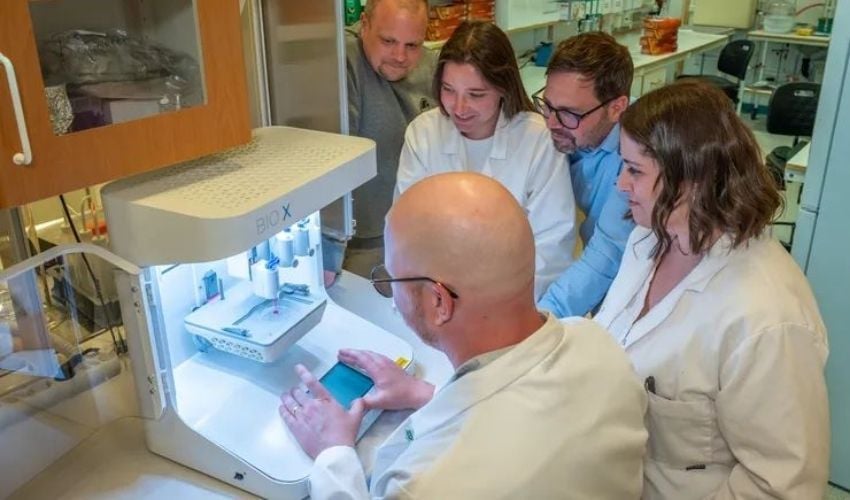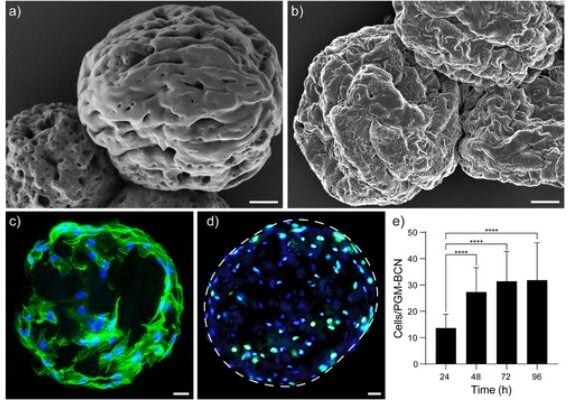3D Printable “Skin in a Syringe” for Healing Burns

Skin is the body’s first line of defense against the outside world, and when it suffers severe burns, repairing it can be a matter of life and death. Current treatments often involve transplanting a thin layer of the epidermis, the outermost skin layer, made up of a single cell type. While lifesaving, this approach frequently results in significant scarring. Now, researchers from the Center for Disaster Medicine and Traumatology and Linköping University have developed a gel containing living cells that they hope to 3D print into skin transplants for burn victims.
Beneath the epidermis lies the dermis, a thicker, more complex layer that houses blood vessels, nerves, hair follicles, and other structures essential for skin’s function and elasticity. Transplanting the dermis itself is rarely feasible, as doing so would create a new wound as large as the original injury. To overcome this challenge, the team sought a new solution: engineering living skin that could replace and regenerate the dermis.

A graphical abstraction of the study. (Image credits: R. Shamasha et al.)
Creating the Bioink
The dermis is made up largely of fibroblasts—connective tissue cells that are both easy to harvest from the body and simple to grow in the lab. These cells are especially valuable because they can mature into more specialized cell types as needed. To cultivate them, the researchers used a scaffold made of tiny, porous gelatin beads. However, this method produced a liquid that would not stay in place on a wound. To solve the problem, they blended the gelatin beads with a hyaluronic acid–based gel, creating a material with a remarkable property: it turns into a liquid when subjected to light pressure.
Daniel Aili, professor of molecular physics at Linköping University and co-lead of the study, explained the substance. “You can use a syringe to apply it to a wound, for example, and once applied, it becomes gel-like again. This also makes it possible to 3D print the gel with the cells in it.”

Scanning electron microscope (SEM) imaging of the cells. (Image credits: R. Shamasha et al.)
For the current study, the team 3D printed small pucks that were placed under the skin of mice. These were created with an extrusion bioprinter. The results demonstrate the potential of this technology to be used to grow the patient’s own cells from a minimal skin biopsy. The patient’s lab-grown cells could then be 3D printed into a graft and applied to the wound. Johan Junker, researcher at the Swedish Center for Disaster Medicine and Traumatology, docent in plastic surgery at Linköping University, and co-lead of the research, spoke of the study’s outcome. “We see that the cells survive, and it’s clear that they produce different substances that are needed to create new dermis,” he said. “In addition, blood vessels are formed in the grafts, which is important for the tissue to survive in the body. We find this material very promising.”
3D Printing for Burns
The study is part of an ongoing trend of scientists looking to improve burn treatment through 3D printing. Earlier this year, for instance, the Centre for Burn Research at the Hamilton Health Sciences (HHS) hospital network in Canada began conducting a trial with bioink made from a patient’s burned skin. Additionally, several research groups have developed 3D printed devices for would treatment, including specialized wound dressings and facial orthoses. To learn more about the Linköping University study, read their article or the study published in Advanced Healthcare Materials.

The bioprinting process (a) and the cell viability expressed as the percentage of live cells relative to the total number of cells within each construct (b). (Image credits: R. Shamasha et al.)
What do you think of the 3D printed skin? Let us know in a comment below or on our LinkedIn or Facebook pages! Plus, don’t forget to sign up for our free weekly Newsletter to get the latest 3D printing news straight to your inbox. You can also find all our videos on our YouTube channel. Interested in more medical and dental 3D printing news? Visit our dedicated page HERE. Interested in more medical and dental 3D printing news? Visit our dedicated page HERE.
*Cover Photo Credit: Magnus Johansson








